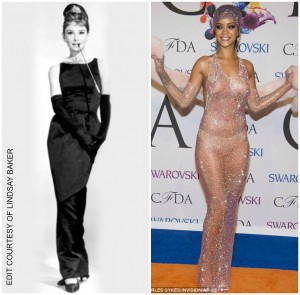
Part of what makes the fashion industry so special is that it is constantly changing. As one can imagine, the industry, who is involved and how it works has shifted dramatically since the 1960’s.
Looking back at the radical world of fashion in the ‘60’s, one of the most admired icons was Audrey Hepburn. Women of all ages have continued to imitate her classic yet chic style. For example, the notorious “little black dress” trend all started when Hepburn wore a Givenchy black floor length dress in the noteworthy film, “Breakfast at Tiffany’s” in 1961. Hepburn still heavily influences people today.
Ashley Van Slyck, a sophomore at Leesville, thinks of Hepburn when deciding what to wear. “[My] style icon is Audrey Hepburn. She had a very good fashion sense,” said Van Slyck. “I like to wear shorts and a blouse [with] Jack Rogers when it’s getting warmer out.”
Another icon from a similar time period is Lesley Hornby, better known by her stage name Twiggy. Twiggy was more than just a successful model in the 1960’s; she was a risk taker when it came to fashion. Her bold outfits made up of shift dresses, mini skirts and knee high boots set trends that are more popular today than ever. Interpretations of fashion pieces such as these can be found in almost every store, making them virtually commonplace in society.
Currently, people are exposed to a completely different set of icons. Rihanna, for instance, could be defined as a style queen. Her fearless outfit choices make her one of the most talked about stars in the fashion world. At the CFDA Fashion Awards, Rihanna wore a pink sheer floor length gown made up of 230,000 Swarovski crystals–something that may have seemed unimaginable fifty years ago. Despite the controversy surrounding Rihanna’s provocative clothing, she continues to make daring strides in the fashion industry–just as Audrey Hepburn and Twiggy did only decades ago.
As far as how the public learns about trends, reliance has always been placed on outside sources. In the ‘60’s, fashion was primarily popularized through the media available at the time–movies and magazines. Consider Hepburn’s iconic style in “Breakfast at Tiffany’s” as an example, in addition to Twiggy’s constant appearances in magazines like Vogue and Seventeen. More recently, these same sources, as well as fashion blogging, play a major role in spreading trends.
Leesville students like Ashley Zung, junior, are influenced by these easily accessible resources. “I like to look at fashion blogs to see what styles are in…it helps me decide what I should buy and wear for that season,” said Zung.
To inspire their followers, modern icons will also use social networking sites like Twitter or Instagram to show off their own outfits or promote brands they endorse. For these reasons, present day fashion is most certainly driven by social media, a revolutionary change from how it was driven in the mid-twentieth century.
How fashion is sold to the public is also vastly different. Early on, higher end fashion was primarily sold in big-city stores like Macy’s and Belk. Most teens in the 60’s and 70’s, like Lisa Baker, Leesville mom, had to “travel an hour and a half to the city” just to buy trendy clothes. Today, it’s more common for notorious designers to sell their products in superstores like Wal-Mart and KMart for a lower price. For example, starting on April 19, Target will sell Lilly Pulitzer apparel, home decor and accessories when previously it was only sold at exclusive boutiques. Selling brands like Lilly Pulitzer at stores virtually everyone has access to helps spread trends faster and over a wider audience.
Despite the differences between the fashion industry of the 60’s and today, the ability to express individuality through style remains the same. That’s one aspect of fashion that will hopefully never change.